Louisiana, with its diverse landscapes and rich biodiversity, is home to a captivating variety of hawks. These majestic birds of prey of Louisiana, known for their keen eyesight, powerful wings, and remarkable hunting skills, grace the skies of the Pelican State.
From the vibrant wetlands of the Mississippi River Delta to the expansive pine forests and coastal marshes, hawks in Louisiana command attention with their aerial acrobatics and striking presence.
Types of Hawk in Louisiana
Red-Tailed Hawks: A common sight throughout Louisiana, including areas like Kisatchie National Forest, Chicot State Park, and the Baton Rouge area.
Red-Shouldered Hawks: Often found in wooded habitats and along waterways, with notable sightings reported in places like Jean Lafitte National Historical Park and Preserve, Atchafalaya National Wildlife Refuge, and Lafayette.
Cooper’s Hawks: Known for its agile flight and woodland preference, the Cooper’s Hawk can be observed in locations such as Cane River Creole National Historical Park, Lake Charles, and the Natchitoches area.
Broad-Winged Hawks: During migration seasons, these hawks can be seen in large numbers soaring above locations like Toledo Bend Reservoir, Catahoula National Wildlife Refuge, and the Alexandria region.
Northern Harrier: Often found hunting over marshes and open fields, the Northern Harrier can be spotted in places such as Sabine National Wildlife Refuge, Lacassine National Wildlife Refuge, and the Calcasieu Lake area.
Sharp-Shinned Hawks: Known for its swift flight and preference for woodland habitats, the Sharp-Shinned Hawk can be observed in areas like Kisatchie National Forest, Bogue Chitto State Park, and Covington.
Swainson’s Hawks: Although less common, Swainson’s Hawks occasionally pass through Louisiana during migration, with potential sightings reported in places such as Cameron Prairie National Wildlife Refuge, Lake Charles, and southwestern Louisiana.
White-Tailed Hawks: This hawk species is a rare visitor to Louisiana, but sightings have been reported in coastal regions such as the Cameron Parish coastline and the Grand Isle area.
Rough-Legged Hawks: During winter months, these hawks may appear in Louisiana’s northern regions, including areas near Kisatchie National Forest, Calcasieu Lake, and Vernon Parish.
Ferruginous Hawk: While not a regular resident, occasional sightings of Ferruginous Hawks have been reported in open grasslands and agricultural areas, particularly in the western part of the state.
Please note that while Harris’s Hawk is not typically found in Louisiana, it is not included in this list as it falls outside the scope of hawks commonly observed in the state.
Louisiana Hawks Photo Guide
Red-tailed Hawk (Buteo jamaicensis)

The Red-tailed Hawk is a large bird of prey that is commonly found across North America. This species is part of the genus Buteo, which is often referred to as the “true hawks,” and includes more than two dozen species of raptors.
Red-tailed Hawks have a robust size, ranging from 18 to 26 inches in length and sporting a wingspan that can exceed 4 feet. They have a broad, rounded set of wings and a short, wide red tail. This species is most easily recognized by its rich, rust-colored tail, which gives it its common name. However, juvenile hawks might not yet have this distinctive feature.
Their feathers are generally dark brown on their dorsal side (back) with a lighter, often speckled, ventral side (front). The intensity and pattern of their plumage can vary significantly based on their age and geographic location, as there are about 14 recognized subspecies of Red-tailed Hawks.
As for their diet, Red-tailed Hawks are carnivores and have a broad diet that includes rodents, ground rabbits, reptiles, and other birds. They are skilled hunters that typically sit on high perches and use their keen eyesight to spot potential prey. Once they have identified a target, they swoop down to capture it with their powerful talons.
Red-tailed Hawks mate for life and build nests high off the ground, often in tall trees or on cliff edges. Their nests are made of sticks and can be quite large. They typically lay 1-3 eggs per year, which are incubated by both parents.
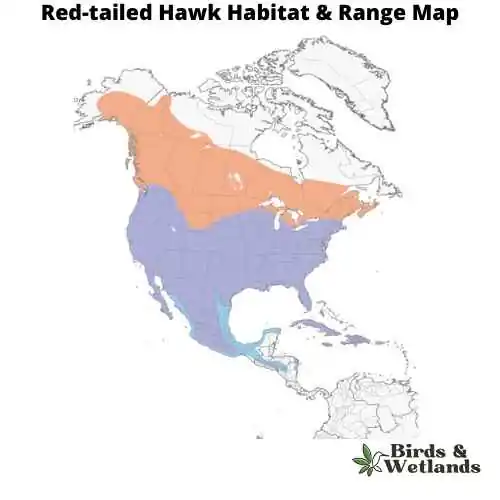
Red-tailed Hawk Sound
Red-shouldered Hawk (Buteo lineatus)
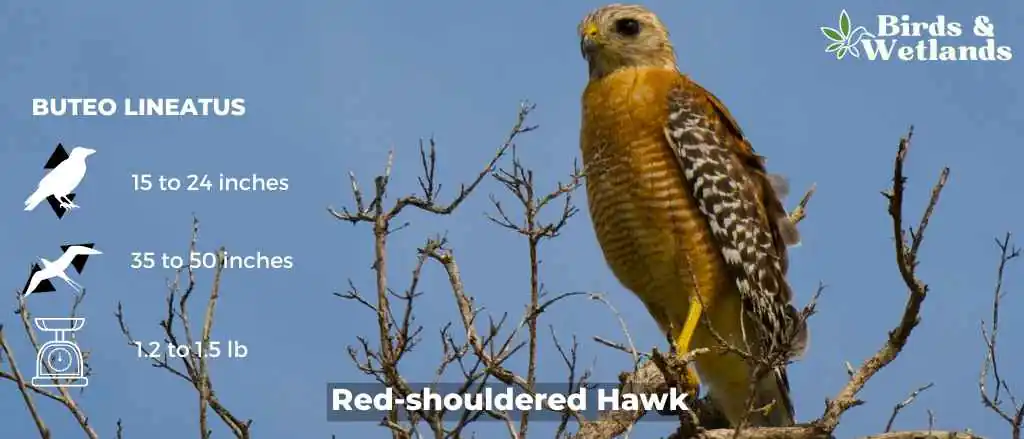

Listen:
The red-shouldered hawk are medium sized birds of prey, part of the buteo hawks family. It can be distinguished from other hawks by its reddish iris and pale legs.
The adult has rusty red upperparts, white underparts, a black chin and throat, and a reddish brown stripe over each eye, reddish brown heads and a strongly banded tail. The tail is reddish brown with two paler bands across it and they have white checkered wings. Juveniles are brown with dark barring and have pale fringes on the feathers of their wings.
Red-shouldered hawks nest in trees, though they also inhabit manmade structures including barns, bridges, and buildings. They prefer wooded areas with an open canopy but will use other places as well for nesting such as shrubs and hedges if needed.
The red-shouldered hawk’s diet – they eat small mammals such as ground squirrels, rabbits, voles, mice and rats. They also eat birds such as quail, pigeons and doves; reptiles including snakes; amphibians; fish; crustaceans; insects; and carrion (dead animals).
Cooper’s Hawk (Accipiter cooperii)
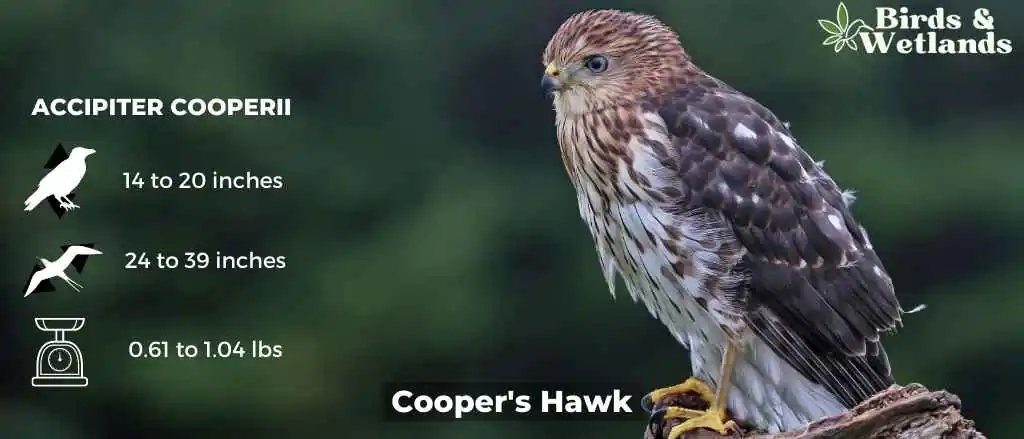
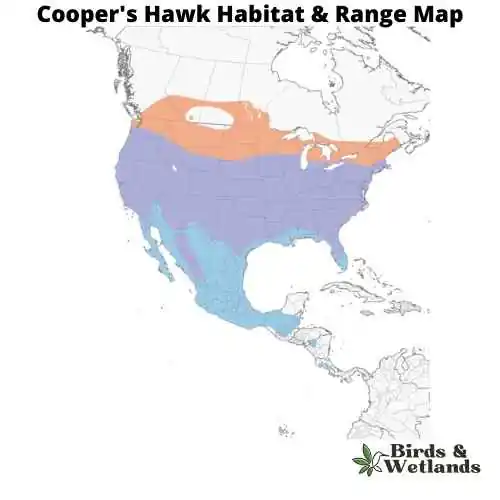
Listen:
The Cooper’s Hawk is a medium-sized bird of prey native to North America. Known for its agility and speed, it is part of the Accipitridae hawk species, which also includes other hawks, eagles, and kites.
Cooper’s Hawks are typically about 14 to 20 inches in length, with a wingspan ranging from 27 to 36 inches. They are known for their distinctive long, rounded tails and short, rounded wings. They have a steely blue gray top, with rusty bars on their underparts and thick, dark bands on their tails.
The Cooper’s Hawk is a skilled predator, primarily hunting birds and small mammals. They are adept at hunting in both dense forests and open areas, often catching prey mid-air in high-speed pursuits. They have also been known to visit the backyard bird feeder, not for the seed, but to prey on the smaller birds that gather there.
Cooper’s Hawks often build nests in dense tree canopies where they are well concealed. The female usually lays 3 to 5 eggs, and both parents share incubation duties. The young hawks fledge after about a month but will stay close to the nest, relying on their parents for food as they learn to hunt.
Broad-winged Hawk (Buteo platypterus)

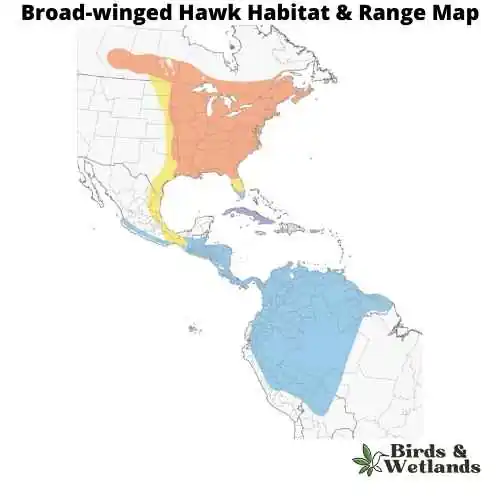
Broad-winged Hawk Sound
The Broad-winged Hawk holds a commanding presence as one of the largest hawks in the world, known for its broad wings. Its formidable size is a testament to its prowess as a bird of prey, effortlessly navigating the open skies in search of food.
Their distinctive appearance sets them apart. The adults exhibit a striking black and white pattern, complemented by a rusty breast and buff underparts and brown wings. In contrast, juveniles are adorned with a brown plumage, marked by pale edges on their feathers, adding to their distinctive youthful charm.
These hawks are most commonly found in open areas, such as farmlands or grasslands interspersed with scattered trees, which provide optimal conditions for when hawks hunt.
When it comes to their diet, Broad-winged Hawks feed on small rodents like mice, rats, squirrels, rabbits, and voles. Broad winged hawks breed during the spring and summer months then migrate to central and south America.
Northern Harrier (Circus hudsonius)

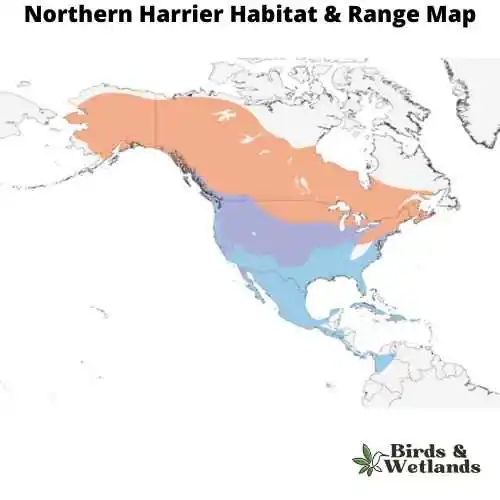
Listen:
The Northern Harrier is a medium-sized, slender hawk.
Adult birds are gray above, with pale bars on the wing feathers and white markings on the underwings and a white rump patch. The breast is barred with black and white, and the belly is streaked with brown.
They prefer open areas, such as grasslands and marshes, but can be found in almost any open habitat except dense woods.
Northern Harriers are opportunistic hunters that feed on small mammals such as mice, voles and rabbits as well as birds including quail, grouse and ducks. They hunt by flying low over open spaces such as fields or marshes.
Northern harrier nests on the ground in lowlands or hillsides near water bodies. It lays two to four eggs which hatch after 24 days of incubation by both parents. The chicks fledge after 30 days of hatching and remain dependent on their parents for another three weeks during which they learn how to fly.
Sharp-shinned Hawk (Accipiter striatus)
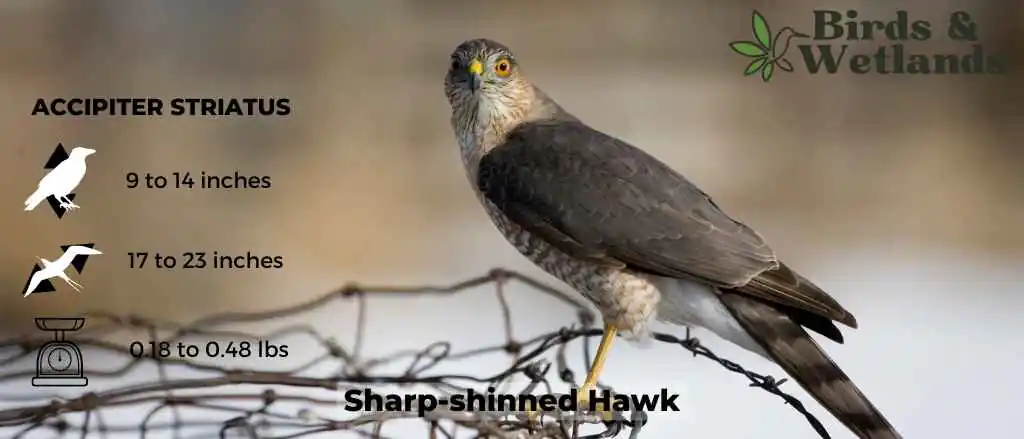
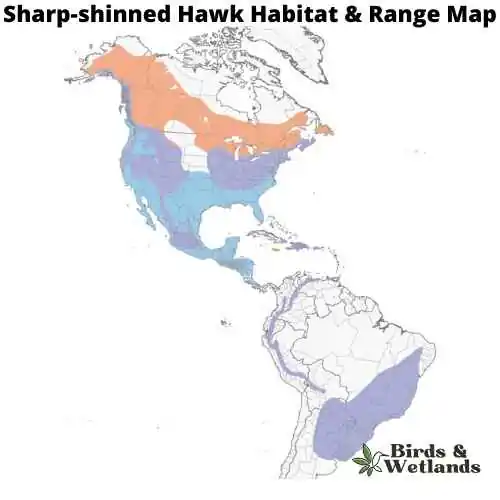
Listen:
The adult bird is brown on top and white underneath, with a dark brown band across its chest. It has short, rounded wings and a long tail that makes it look larger than it actually is. Adult sharp shinned hawks have black eyes, which are surrounded by white feathers. The female Sharp-shinned Hawk is browner than the male, who has darker brown markings on his back.
Sharp-shinned Hawks prefer open country for their habitat, including fields and meadows where they can hunt for mice and other small animals. They can be found throughout the United States but are most common in the east.
Sharp-shinned Hawks eat mostly small birds, such as sparrows and warblers, as well as small mammals such as mice and gophers. They catch prey by surprise using their incredible speed and agility, diving out of the sky at speeds up to 200 mph.
Sharp-shinned Hawks have an unusual hunting style for hawks—they prefer to catch their prey from perches above trees or telephone wires, rather than swooping down from above like most other hawks do and can often be seen hunting near bird feeders.
Swainson’s Hawk (Buteo swainsoni)
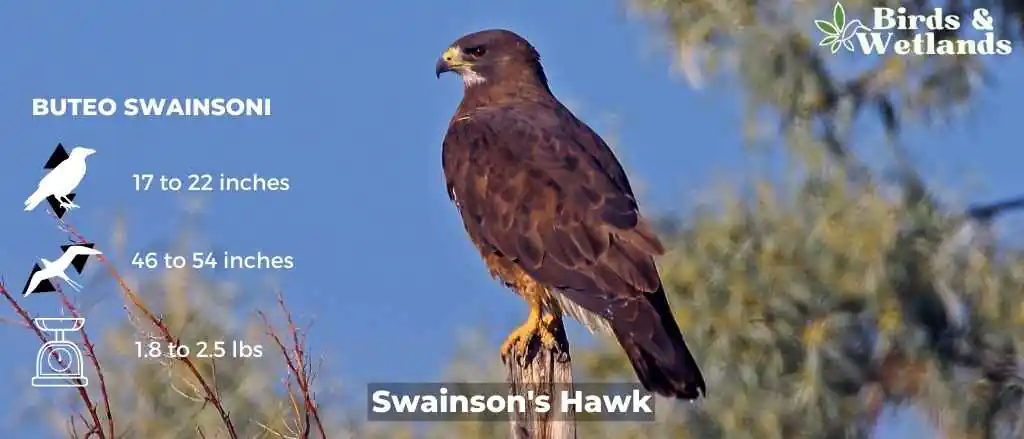
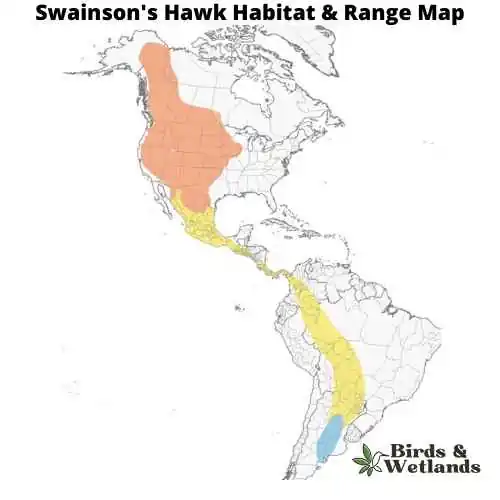
Listen: Swainson’s Hawk
Swainson’s Hawk is a medium-sized hawk that is found in North America and South America, Scientific Name: Buteo swainsoni.
The bird has a blue-gray plumage with a dark brown back, wings, and tail. It also has a white chest and belly. The beak and feet are black, but the eyes are yellow. They are often confused with Cooper’s Hawk because of similar coloring, but Swainson’s Hawks have wider tails and longer wings than their cousin species.
These birds eat small rodents such as gophers and mice. They also eat insects like grasshoppers and crickets during the summer months when they’re plentiful. They sometimes steal prey from other birds of prey such as Northern Harriers who hunt the same prey.
Swainson’s Hawks build nests on rocky cliffs near water sources where they can find food easily. They lay three to five eggs that hatch after about two months into fluffy brown baby hawks who leave the nest after about three weeks (or when they’re big enough).
White-tailed Hawk (Geranoaetus albicaudatus)
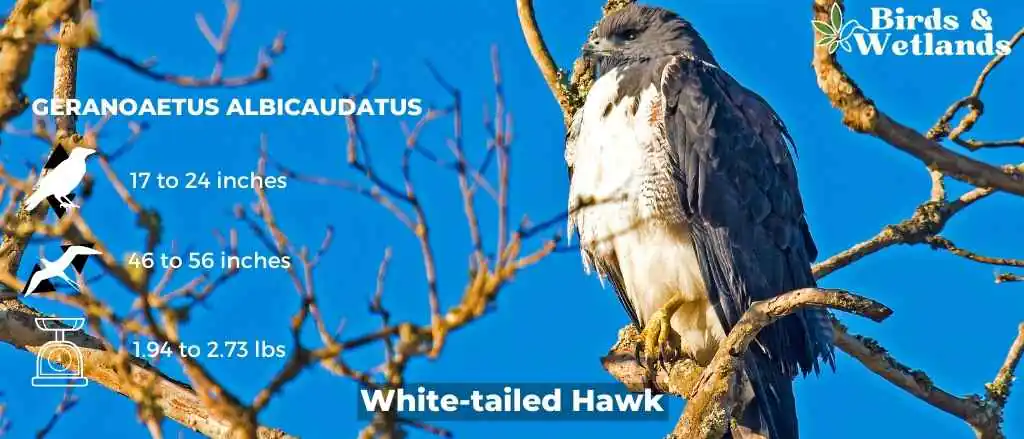
The white-tailed hawk is a medium-sized bird of prey found in North America. It is one of the most common hawks on the continent, and it is often seen soaring high above the ground on its long wings.
- Scientific Name: Geranoaetus albicaudatus
- Length: 44–60 cm (17–24 in)
- Wingspan: 118–143 cm (46–56 in)
- Weight: 880–1,240 g (1.94–2.73 lb)
White-tailed Hawk Description
The white-tailed hawk has a large body and broad wings, with a tail that is mostly white with black bars. The head is grayish-brown, and there are white streaks above the eyes. The breast is grayish, while the belly is brownish-gray. The feathers on the back are dark brown with pale edges. The underwing coverts are white with brown tips. The white-tailed hawk has a black bill and brown legs. The eyes are yellow or orange with red orbital rings.
White-tailed Hawk Sound
White-tailed Hawk Habitat & Range
White-tailed hawks live in open country, including fields, deserts, grasslands, and even mountains. They like flat areas to hunt from so they can see their prey from far away. It can be found as far north as Canada and as far south as Mexico.
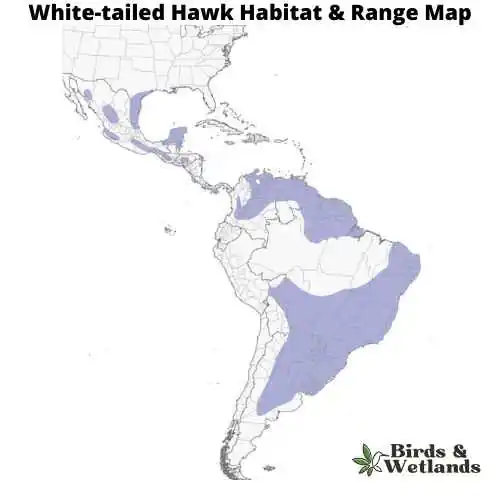
White-tailed Hawk Diet
White-tailed hawks eat small animals like mice, rats, rabbits, squirrels, birds (including chickens), reptiles (like snakes), amphibians (like frogs or toads), insects like grasshoppers and beetles as well as carrion (dead animals) such as road-killed deer or raccoons.
White-tailed Hawk Nesting
The White-tailed Hawk nests in tree cavities or on the ground, depending on the location. The female lays two eggs at a time and incubates them while the male hunts for food. After about two months, the eggs hatch and both parents take turns feeding their young until they are old enough to leave the nest on their own.
Rough-legged Hawk (Buteo lagopus)

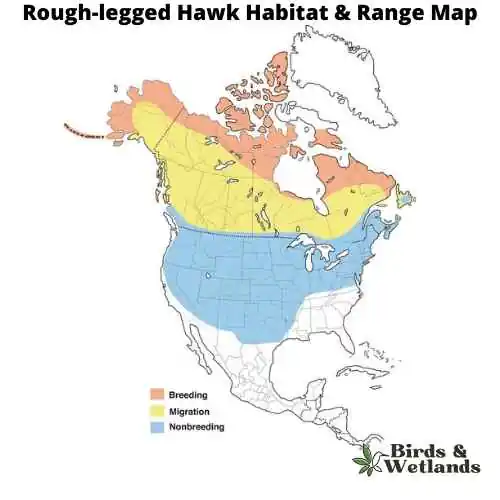
Rough-legged Hawk Sound
The Rough-legged Hawk is a large, raptor that is native to North America. It is also known as the American Rough-legged Hawk. Scientific Name: Buteo lagopus
The Rough-legged Hawk is a medium-sized hawk with a distinctive appearance, with dark brown feathers on its back and light brown feathers on its underside and broad thin wings. The hawk’s legs are also covered in dark feathers, which help to distinguish it from other species of hawk. The tail is barred with black and white. They have yellow eyes and dark feet.
Rough-legged Hawks hunt from above ground level, swooping down to catch its prey in its talons. When hunting for food, they prefer to eat small mammals such as squirrels and rabbits but will also eat birds if there aren’t any small mammals available. Although they eat a variety of small animals including birds, rodents, bats and reptiles, they rely heavily on fish for food during breeding season because it provides them with protein and calcium needed to produce eggs.
Ferruginous Hawk (Buteo regalis)

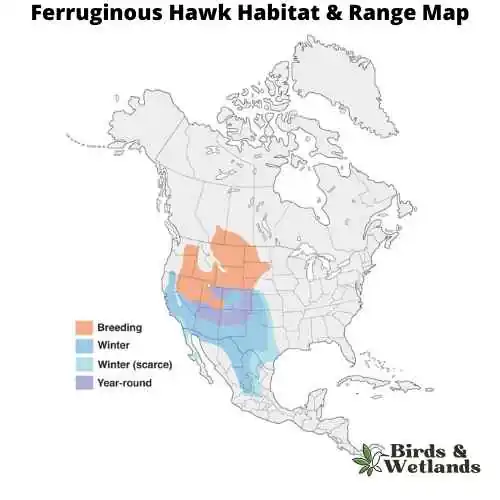
Ferruginous Hawk Sound
Scientific Name: Buteo regalis
Length: 20 to 27 in
Wingspan: 48 to 60 in
Weight: 32.0 to 80.0 oz
The Ferruginous Hawkis the largest hawk species native to North America. Known for its distinctive coloration and impressive size, this bird of prey predominantly inhabits the open landscapes of the western United States and parts of Canada.
Ferruginous Hawks are notable for their “ferruginous” or rust-colored back and shoulders, which contrasts sharply with the bird’s white underside. The hawk also has broad, rounded wings and a large, gape-mouthed beak. Ferruginous hawks exhibit dark morph and light morphs. Dark morphs have dark brown plumage, while light morphs display lighter, reddish-brown plumage. Morphs vary geographically.
Primarily feeding on small to medium sized mammals like rabbits and prairie dogs, the Ferruginous Hawk is an agile hunter, often seen soaring high above the ground or perched prominently while scanning for prey. It occasionally feeds on birds, reptiles, and insects as well.
Nesting for Ferruginous Hawks typically occurs on cliffs, hillsides, or large trees. The female lays between 2 to 5 eggs, and both parents share in the incubation and rearing of the chicks. The Ferruginous Hawk is a relatively solitary bird outside of the breeding season, and its call is a loud, high-pitched scream, often heard during courtship or near the nest.

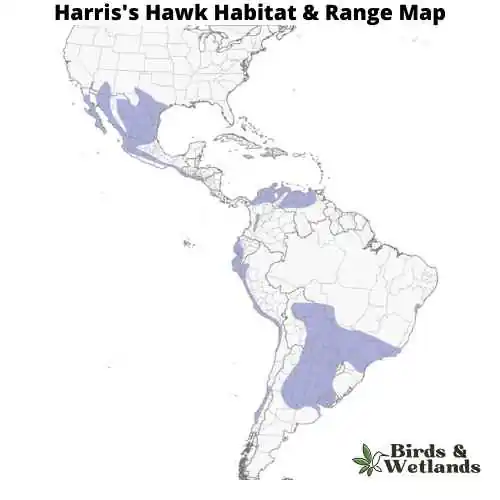
Harris’s Hawk Sound
Scientific Name: Parabuteo unicinctus
Length: 18 to 23 in
Wingspan: 41 to 47 in
Weight: 1.2 to 3.6 lb
The Harris’s Hawk is a unique bird of prey, recognized by its distinct social behavior and richly colored plumage. This raptor prefers semi-arid habitats like desert scrub, woodlands, and savannas.
Harris’s Hawk sports a dark brown or chestnut-brown body, with striking reddish-brown shoulders and legs. A characteristic feature of this bird is its white-tipped tail, along with a white band on the underside of its tail feathers.
Harris’s Hawks diet mainly consists of small mammals, birds, and lizards. One of the unique behavioral traits of this species is that it often hunts cooperatively in groups, a rarity among raptors. This group hunting strategy often involves surrounding and flushing out prey, or taking turns chasing it, which increases the likelihood of a successful hunt. Harris’s Hawk also engage in “stacking,” where they perch on top of each other, which is a behavior rarely seen in birds of prey.
Nesting for Harris’s Hawks involves the building of a platform of sticks in a tree or cactus, where the female usually lays 2 to 4 eggs. Both parents share in the incubation and rearing of the chicks, with sometimes even older offspring assisting in the process.
Where to Spot Hawks in Louisiana
Kisatchie National Forest: Located in central Louisiana, Kisatchie National Forest offers diverse habitats, including pine forests and hardwood bottoms. This area attracts a variety of hawk species, including Red-tailed Hawks, Cooper’s Hawks, and Red-shouldered Hawks.
Atchafalaya National Wildlife Refuge: Situated in southern Louisiana, the Atchafalaya National Wildlife Refuge provides a mix of wetlands, bottomland hardwoods, and open marshes. It serves as an important habitat for hawks such as Broad-winged Hawks, Swainson’s Hawks, and Northern Harriers.
Cameron Prairie National Wildlife Refuge: Located in southwestern Louisiana, Cameron Prairie NWR features marshes, prairies, and freshwater impoundments, attracting a diverse range of hawks. Look for species like Northern Harriers, Red-tailed Hawks, and the occasional Rough-legged Hawk during winter months.
Catahoula National Wildlife Refuge: Situated in central Louisiana, Catahoula NWR encompasses a mix of bottomland hardwood forests, open fields, and wetlands. It provides a habitat for hawks like Red-shouldered Hawks, Cooper’s Hawks, and occasionally Northern Harriers.
| Neighbouring State’s Hawks | Hawk Watching Site |
|---|---|
| Hawks found in Texas | Smith Point Hawk Watch |
| Hawks found in Arkansas | Mount Magazine State Park |
| Hawks found in Mississippi | Strawberry Plains Audubon Center |

